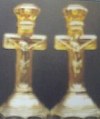Carnival Glass 101 | home Quick Reference to Carnival Glass Patterns on This Site
Millersburg - Part 2
MILLERSBURG - Part 2
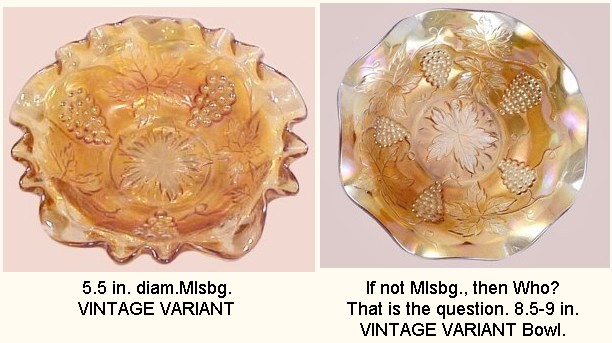
VINTAGE VARIANT: This segment may raise a few “surprised eyebrows” since at least a couple of the examples shown/discussed are not to be found in Millersburg Glass - As I Know It by Marie McGee, c. 1995. Her book covers the well-known patterns produced by that member of the “big five” manufacturers of vintage carnival glass, but as with most areas of collectibles, there are exceptions. From that standpoint, leniency in foregone conclusions must enter the picture.
In the late 1980s, Dean & I discovered a 9”, six ruffle marigold bowl with a Vintage Variant design quite apart from the standard Millersburg VINTAGE pattern. It had a paneled back with a star inside the marie, and first impulse called to Millersburg as maker. Not long after, the late John Britt found a green example in the same bowl. John and Lucile and we agreed that the pieces were of Millersburg origin since another collector had reported an amethyst example to John.
Certainly the edge treatment and the radium finish on these pieces speak to Millersburg as the manufacturer. We cling to that belief today. These moulds may have been made at the time radium processing came into being. Hence the Wide Panel exterior. Considering the success Fenton achieved with their many Vintage patterns, logical thinking follows that a new pattern to be made in “radium treatment” would meet success, as well. Lack of orders and limited production may have been the outcome; leading to the scarcity of those examples today?
We sold the 9” bowl several years ago to a collector who was convinced of the Millersburg origin, but when we discovered the 5.5” marigold example shown here, having all the characteristics of that manufacturer, including the unmistakable edge, we decided to continue with the name VINTAGE VARIANT and allow our viewers to decide for themselves who may have made the pattern. These examples are extremely rare, seldom revealing themselves for collector advantage, yet like all “virtual unknowns”, receive no rave reviews. What a pity!
Why does the sauce have only three bunches of grapes? Artistry involves “balance” of design. Mould makers were artisans of the highest order! If you had been asked to achieve a nicely balanced application of “like design” to compliment the larger bowl having five bunches of grapes, how would you have approached the possibilities? We too, believe the optimum was achieved! Study of the many Fenton “Vintage” designs illustrates the point to the utmost. Design balance was adjusted to suit the size bowl in question.
The following letter was received from Marie McGee of Fresno, CA; dated Aug. 26, 1990.
As editor of their quarterly newsletter at the time, I wrote an article on the subject, for inclusion in the San Diego Club Newsletter, which produced the response copied here, verbatim:
“Dear Diane,
I was quite interested with your article, “A Variation on the Theme “Vintage”. That's the first pattern that was believed by Sherman Hand to be Millersburg that I questioned and have done a lot of research on. I believe it is probably a variant but was made by Fenton.
My first point is the leaves. All Millersburg leaves have many veins and all are stippled. The Vintage leaf is very different in both shape & finish. Next, I looked at the tendrils which have 1 loop, while every Millersburg has 2 or 3 loops very elaborately drawn. Next is color. The Vintage is found in colors not known to Millersburg; namely red and white. I will agree that it has a radium finish but I can't see the “Millersburg radium iridescence.”
See Fenton -The First 25 Years, page 50-#222 by Bill Heacock; also the Butler Brothers Catalog. The late Bill Heacock and I talked about this pattern. He definitely believed it was Fenton, but he also had Vintage shards from Dugan's Vintage.
The true Fenton Vintage has a wide paneled back and a starred base. As far as the size of the grapes, there seems to be different sizes and various numbers of bunches on all the grape patterns from every company. I've gone so far as to count each grape on many patterns but there's no definite rule on that research.
There does seem to be a difference in the shape with grapes & bunches. Northwood, Fenton & Imperial seem to be mostly round with bunches, while Millersburg are oblong shapes.
Grape Leaves by Millersburg are different, but they look more like a berry than grapes, but look at the leaves.
(Marie includes a diagram of Vintage and Grape & Cable leaves, both having 5 points)
I have a couple of 5” sauces in the pattern-a 3 and 1 edge and a ruffled one. I also owned a Vintage compote, but since it was the exact mold as the Iris compote, I was positive it was Fenton, which later it was proved to be Fenton. The sauces I still have because I think they are pretty but don't have them in Millersburg cabinets.
Diane, these are my opinion from my research. One good thing about being a collector, we own them, so we can call them anything we want to, huh?
Your newsletter was super, as always. Thanks for the coverage of my program. Marie”
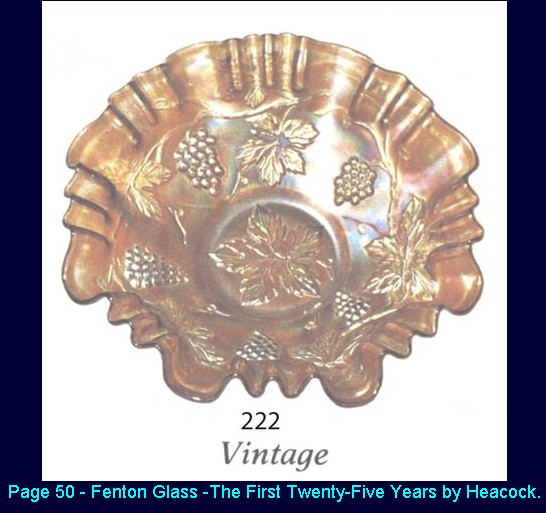
For further study surrounding Fenton and Dugan Vintage patterns, please click on -  - in our homepage pattern alphabet to be taken directly to that segment.
- in our homepage pattern alphabet to be taken directly to that segment.
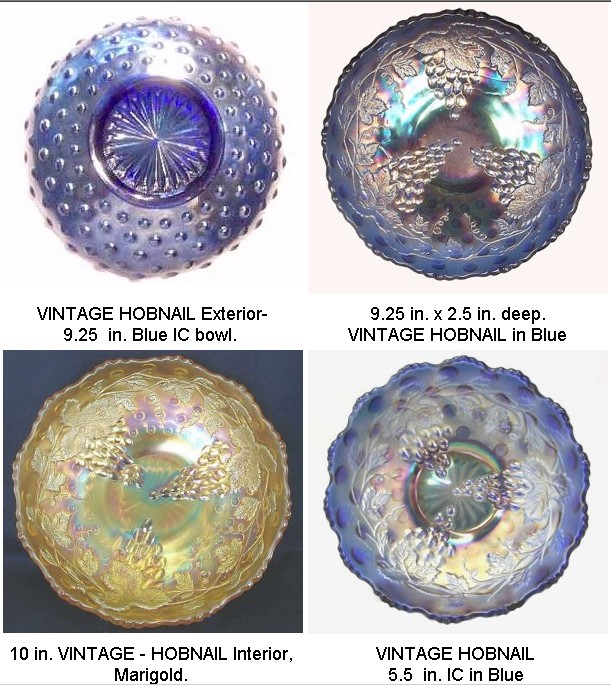
VINTAGE Hobnail: 9 ½”, 10”, bowls and 5 ½” sauce dishes are the known sizes in this pattern; all having the HOBNAIL exterior. A simple pattern, well-balanced and quite lovely. Three large bunches of grapes hanging from a wreath of leaves appears very realistic. Notice the rayed star within the marie. They can be ruffled, ice cream shape or have the 3-1 edge. Large bowls known in green and marigold. These are the easiest to locate. A 3-1 edge and the ice cream shaped blue are the only two known in that color. 5 ½” sauces are rare in amethyst, blue and green, with perhaps 8-9 in marigold carnival.
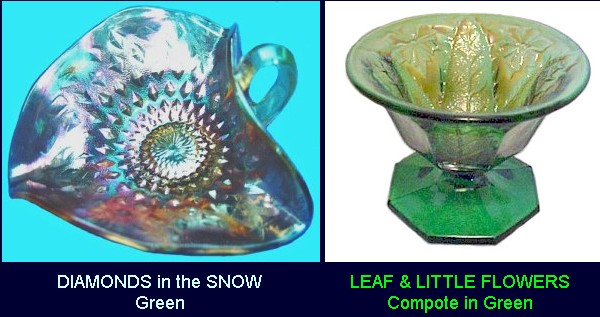
DIAMONDS in the SNOW: This is another design believed by many early collectors to have been made by Millersburg Glass Co. When the first amethyst single handled nappy was presented to John Britt in the 1980s while we were all attending a HOACGA Convention, the name was applied and the designation of manufacturer was decided upon. Since that time, a green one or two have turned up. These are as rare as the Vintage Variant examples, certainly.
LEAF and LITTLE FLOWERS: Considered a miniature compote, it is 3” tall, having a bowl diameter of 3 ¾”. These can be found to have round or ruffled tops in amethyst, green and marigold carnival. Green and amethyst ruffled shapes with radium finish will usually bring the most money, but marigold examples are more difficult to find. The same base mould was used for the couple of extremely rare Olympic compotes-one in amethyst and one in green.
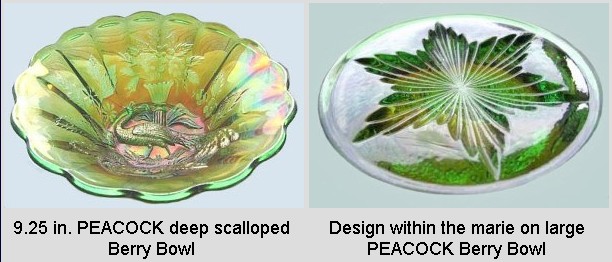
PEACOCK: Millersburg Peacock has no bee and no beading on the urn. Large ice cream shaped bowls are quite desirable, displaying the pattern to great advantage. More of this shape in 9”-10” and the small ice cream shape, about 6”, are available than those in this 9”-10” and 6” size flared berry bowl shape. Wide Panel is the exterior design.
Amethyst, green and marigold are colors found in both the large and small berry bowls. A few of the small bowls are known in blue.
Star within the marie: Other than the exterior designs found on some Millersburg patterns which were carried over into Carnival production following the crystal period, few designs are expounded upon. We believe this star is executed quite nicely and thought our viewers would appreciate seeing it.
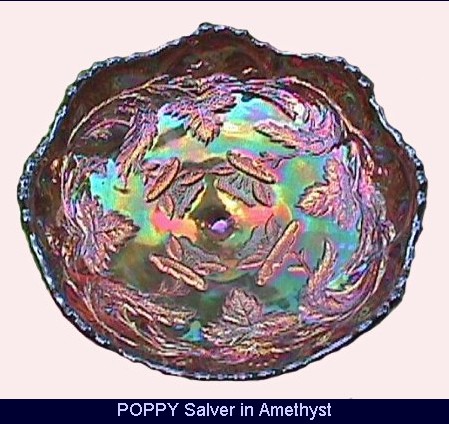
POPPY Salver: Two shapes are known in this compote, both having an interior poppy pattern with the Potpourri design on the exterior, extending to the base of the stem. Most often seen in the 6” tall style with a 7” diameter deep bowl and slightly turned out edge. All of these compotes offer good color and the radium finish.
These flattened top or “salver” types are very rare. The bowl is flattened to about 8” with the edges of the bowl straight up. Carnival glass colors are: one amethyst, two green, one marigold. Of those three colors, marigold is more difficult to locate in either of the varieties.
Dean & Diane Fry, 2/07
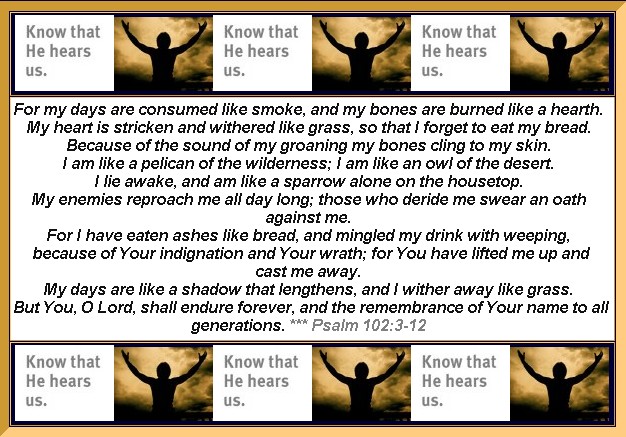



Should you care to contact the Frys, their email address is:
Search Our Sites
back to Carnival Glass 101
Our other sites you may enjoy:
Everything you EVER wanted to know about Indiana Glass
Great Reference for Newer Carnival Glass.
Complete Glassware Catalogs Available to Download
Questions? Comments? Suggestions? Broken Links? Corrections?
Your Friendly Webmaster is here to help!
